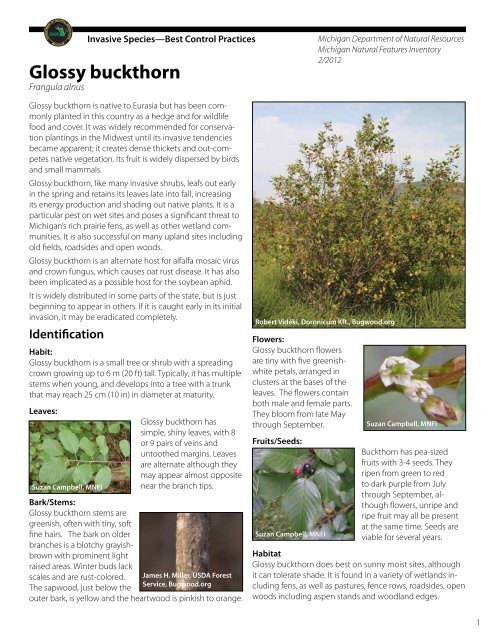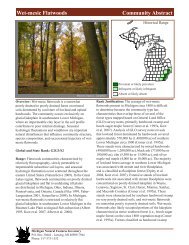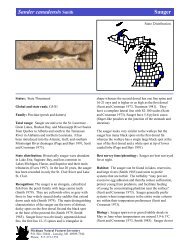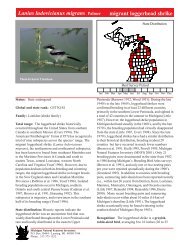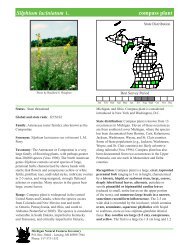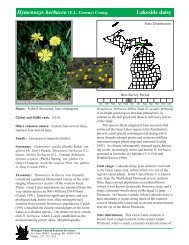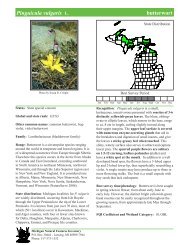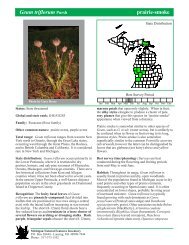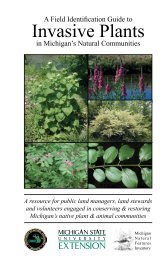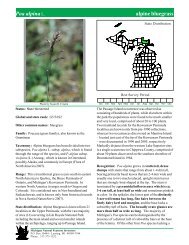Glossy buckthorn - Michigan Natural Features Inventory
Glossy buckthorn - Michigan Natural Features Inventory
Glossy buckthorn - Michigan Natural Features Inventory
You also want an ePaper? Increase the reach of your titles
YUMPU automatically turns print PDFs into web optimized ePapers that Google loves.
Invasive Species—Best Control Practices<br />
<strong>Glossy</strong> <strong>buckthorn</strong><br />
Frangula alnus<br />
<strong>Glossy</strong> <strong>buckthorn</strong> is native to Eurasia but has been commonly<br />
planted in this country as a hedge and for wildlife<br />
food and cover. It was widely recommended for conservation<br />
plantings in the Midwest until its invasive tendencies<br />
became apparent; it creates dense thickets and out-competes<br />
native vegetation. Its fruit is widely dispersed by birds<br />
and small mammals.<br />
<strong>Glossy</strong> <strong>buckthorn</strong>, like many invasive shrubs, leafs out early<br />
in the spring and retains its leaves late into fall, increasing<br />
its energy production and shading out native plants. It is a<br />
particular pest on wet sites and poses a significant threat to<br />
<strong>Michigan</strong>’s rich prairie fens, as well as other wetland communities.<br />
It is also successful on many upland sites including<br />
old fields, roadsides and open woods.<br />
<strong>Glossy</strong> <strong>buckthorn</strong> is an alternate host for alfalfa mosaic virus<br />
and crown fungus, which causes oat rust disease. It has also<br />
been implicated as a possible host for the soybean aphid.<br />
It is widely distributed in some parts of the state, but is just<br />
beginning to appear in others. If it is caught early in its initial<br />
invasion, it may be eradicated completely.<br />
Identification<br />
Habit:<br />
<strong>Glossy</strong> <strong>buckthorn</strong> is a small tree or shrub with a spreading<br />
crown growing up to 6 m (20 ft) tall. Typically, it has multiple<br />
stems when young, and develops into a tree with a trunk<br />
that may reach 25 cm (10 in) in diameter at maturity.<br />
Leaves:<br />
Suzan Campbell, MNFI<br />
Bark/Stems:<br />
<strong>Glossy</strong> <strong>buckthorn</strong> stems are<br />
greenish, often with tiny, soft<br />
fine hairs. The bark on older<br />
branches is a blotchy grayish-<br />
brown with prominent light<br />
raised areas. Winter buds lack<br />
scales and are rust-colored.<br />
The sapwood, just below the<br />
<strong>Glossy</strong> <strong>buckthorn</strong> has<br />
simple, shiny leaves, with 8<br />
or 9 pairs of veins and<br />
untoothed margins. Leaves<br />
are alternate although they<br />
may appear almost opposite<br />
near the branch tips.<br />
James H. Miller, USDA Forest<br />
Service, Bugwood.org<br />
outer bark, is yellow and the heartwood is pinkish to orange.<br />
Flowers:<br />
<strong>Glossy</strong> <strong>buckthorn</strong> flowers<br />
are tiny with five greenishwhite<br />
petals, arranged in<br />
clusters at the bases of the<br />
leaves. The flowers contain<br />
both male and female parts.<br />
They bloom from late May<br />
through September.<br />
Fruits/Seeds:<br />
<strong>Michigan</strong> Department of <strong>Natural</strong> Resources<br />
<strong>Michigan</strong> <strong>Natural</strong> <strong>Features</strong> <strong>Inventory</strong><br />
2/2012<br />
Robert Vidéki, Doronicum Kft., Bugwood.org<br />
Suzan Campbell, MNFI<br />
Suzan Campbell, MNFI<br />
Buckthorn has pea-sized<br />
fruits with 3-4 seeds. They<br />
ripen from green to red<br />
to dark purple from July<br />
through September, although<br />
flowers, unripe and<br />
ripe fruit may all be present<br />
at the same time. Seeds are<br />
viable for several years.<br />
Habitat<br />
<strong>Glossy</strong> <strong>buckthorn</strong> does best on sunny moist sites, although<br />
it can tolerate shade. It is found in a variety of wetlands including<br />
fens, as well as pastures, fence rows, roadsides, open<br />
woods including aspen stands and woodland edges.<br />
1
2<br />
Similar species<br />
Common <strong>buckthorn</strong><br />
The related common <strong>buckthorn</strong><br />
(Rhamnus cathartica)<br />
has finely toothed leaves<br />
and flowers with four petals<br />
rather than five. Often, it has<br />
a small thorn at the tip<br />
of its branches, between the terminal buds, which are covered<br />
by scales. It has 3 to 5 leaf veins rather than the 8 or 9<br />
of glossy <strong>buckthorn</strong>. It is also invasive.<br />
Alder-leaved <strong>buckthorn</strong><br />
Bev Walters,<br />
University of <strong>Michigan</strong><br />
Dogwoods<br />
Dogwoods (Cornus spp.)<br />
have opposite leaves rather<br />
than alternate and their fruit<br />
and flowers are arranged in<br />
clusters on reddish stems.<br />
The fruit is blue or white,<br />
rather than deep purplish<br />
black.<br />
Paul Wray, Iowa State<br />
University, Bugwood.org<br />
The native alder-leaved<br />
<strong>buckthorn</strong> (Rhamnus alnifolia)<br />
is less than 1 m (3 ft) tall and<br />
has leaves with tiny rounded<br />
teeth and 6 or 7 pairs of<br />
veins. Its flowers lack petals<br />
but have five sepals, rather<br />
than four. It grows in fens and<br />
other wetlands.<br />
Suzan Campbell, MNFI<br />
Reproduction/Dispersal<br />
<strong>Glossy</strong> <strong>buckthorn</strong> reproduction is primarily by seed. Buckthorn<br />
is insect pollinated and cannot self-fertilize. Plants<br />
mature quickly and can produce fruit at heights of less than<br />
1 m (~3 ft) tall. They can also sprout from the root crown<br />
when cut. Plants that have been top-killed can produce fruit<br />
on new shoots within the same season.<br />
Although many glossy <strong>buckthorn</strong> seedlings appear under<br />
their parent plants, germination and seedling survival rates<br />
are highest in full sun on exposed soils. <strong>Glossy</strong> <strong>buckthorn</strong> often<br />
establishes in open fields, in the sunny edge along paths<br />
and roads and along the forest edge. Following removal of<br />
mature shrubs, abundant seedlings rapidly germinate and<br />
must be considered when formulating control strategies.<br />
Birds are a major dispersal agent for glossy <strong>buckthorn</strong>. Robins,<br />
cedar waxwings, rose-breasted grosbeaks and starlings<br />
have been observed feeding on their abundant fruits. The<br />
unripe fruit contains the chemical emodin, which has a<br />
laxative effect, facilitating its spread. Small mammals also<br />
disperse glossy <strong>buckthorn</strong> seed, particularly rodents. Mice<br />
eat and store glossy <strong>buckthorn</strong> fruit and seedlings sprout<br />
from their abandoned caches.<br />
Fruit production is greatest on sites in full sun with moist<br />
soils. Plants in shadier conditions can persist without fruiting<br />
for years until a gap in the canopy appears and they receive<br />
enough sunlight to flower and fruit.<br />
Planning a control program<br />
Resources for invasive species control invariably fall short of<br />
the actual need, so it is important to prioritize sites for treatment<br />
and plan carefully. Assessing both the scope of the<br />
problem and any available resources is a critical first step:<br />
• Map known populations; is the species widely distributed<br />
throughout the region? Just beginning to appear?<br />
• Does it occur on high value sites? Important hunting or<br />
recreational lands? High quality natural areas? Sites with<br />
high cultural value?<br />
• How is it distributed? Is it sparsely scattered in otherwise<br />
native vegetation? Does it cover large expanses of low<br />
quality habitat?<br />
• Is there the potential to utilize volunteers?<br />
Given this information, develop a strategy for control:<br />
1. Prioritize high value sites where success can be<br />
achieved for treatment;<br />
2. Choose appropriate control methods, given site conditions<br />
and available resources.<br />
3. Do these control methods require any permits (i.e. herbicide<br />
application in wetlands, prescribed burning)?<br />
4. Focus on mature plants, particularly those in full sun<br />
with abundant fruit;<br />
5. Eradicate smaller satellite populations;<br />
6. Treat larger core infestations of lower value as<br />
resources permit.<br />
7. Monitor to ensure desired results are being achieved;<br />
adapt management to improve success.<br />
Best survey period<br />
Because glossy <strong>buckthorn</strong> leafs out early and retains its<br />
leaves late in fall in much of the state, it is often easiest to<br />
locate for mapping or control efforts in early spring or late<br />
fall when the leaves of native vegetation are absent or have<br />
changed color. It is also easier to distinguish from its neighbors<br />
when in fruit.<br />
Documenting occurrences<br />
In order to track the spread of an invasive species on a<br />
landscape scale, it is important to report populations where<br />
they occur. The Midwest Invasive Species Information Network<br />
(MISIN) has an easy-to-use interactive online mapping<br />
system. It accepts reports of invasive species’ locations from<br />
users who have completed a simple, online training module<br />
for the species being reported. It also offers the potential for
atch uploading of occurrence data for any invasive species.<br />
Herbaria also provide a valuable and authoritative record of<br />
plant distribution. The University of <strong>Michigan</strong> Herbarium’s<br />
database can be searched online for county records of<br />
occurrence, for example. When glossy <strong>buckthorn</strong> is first<br />
encountered in a county where it had not been known previously,<br />
specimens should be submitted to the Herbarium<br />
to document its presence. Check the “Online Resources”<br />
section for links to both of these resources.<br />
Control<br />
A primary goal in controlling this species is to prevent seed<br />
production and dispersal. <strong>Glossy</strong> <strong>buckthorn</strong> is one of the<br />
most difficult invasive shrubs to control. A variety of techniques<br />
including both mechanical and chemical controls<br />
may be most effective and should be tailored to the specific<br />
conditions on the site. It is critical to monitor the site to<br />
ensure that cut stumps and treated shrubs do not resprout<br />
and that the seedbank is exhausted. Removal of a dense<br />
glossy <strong>buckthorn</strong> thicket “overstory” results in dense seedling<br />
response. Where abundant seed sources are present<br />
nearby, monitoring may be required indefinitely.<br />
Mechanical control<br />
In the very earliest stages of invasion, when only scattered<br />
seedlings and young plants are present, mechanical<br />
controls such as pulling and digging may be adequate to<br />
control or eradicate glossy <strong>buckthorn</strong>. Mechanical control<br />
methods are particularly useful where volunteers are available.<br />
These methods are impractical in larger, established<br />
infestations, with mature shrubs, but may effectively supplement<br />
the use of herbicide.<br />
Pulling<br />
In loose, sandy soils, glossy <strong>buckthorn</strong> seedlings can be<br />
hand-pulled easily, particularly when the soil is moist and<br />
the population is small. Pull steadily and slowly to minimize<br />
soil disturbance and tamp down the soil afterwards. In<br />
heavier soils, however, roots are so tenacious that the bark<br />
strips off the seedling when pulled. Tools such as the Weed<br />
Wrench® or Root Talon® provide additional leverage, facilitating<br />
the removal of somewhat larger plants.<br />
Cutting/Mowing<br />
Cutting or mowing mature glossy <strong>buckthorn</strong> shrubs stimulates<br />
resprouting unless the cut surfaces are treated with<br />
herbicide. Mowing may be helpful in maintaining open<br />
areas by preventing the establishment of seedlings.<br />
Girdling<br />
For mature, single-stemmed <strong>buckthorn</strong> specimens, girdling<br />
may be easier than removing the entire tree. Girdling entails<br />
the removal of a strip of bark and cambium around the<br />
trunk. The cambium, a thin layer just inside the bark, transports<br />
water and nutrients between the plant’s roots and<br />
its leaves. When it is cut, the tree slowly begins to die.<br />
Use an axe or saw to make two parallel horizontal cuts<br />
around the trunk several inches apart, cutting through the<br />
bark and cambium. Then, knock off the bark between the<br />
cuts. The tree should be checked periodically for two years<br />
to cut off any resprouts and to ensure that the bark does not<br />
heal over. Girdling is more effective when used in conjunction<br />
with herbicide.<br />
Flooding<br />
On wetland sites where water levels have been lowered<br />
artificially, restoring the hydrology may kill or set back<br />
glossy <strong>buckthorn</strong>. An extended period of flooding during<br />
the growing season is required. The duration and timing<br />
of flooding is as important as water depth. This is perhaps<br />
most appropriate where restoring hydrology is part of a<br />
larger management program and should be used in conjunction<br />
with other control methods as needed. It is important<br />
not to raise water levels higher than they were historically,<br />
to avoid harming sensitive native vegetation.<br />
Chemical control<br />
In most cases, effective control of glossy <strong>buckthorn</strong> requires<br />
the use of herbicide. Factors that should be considered<br />
when selecting an herbicide for use on a particular site include<br />
proximity to water or wetlands, presence or absence<br />
of desirable native vegetation, potential for erosion and the<br />
effectiveness of the herbicide under consideration on glossy<br />
<strong>buckthorn</strong>. Because glossy <strong>buckthorn</strong> remains green much<br />
later than many native species, fall treatment may minimize<br />
damage to desirable broadleaf plants.<br />
General considerations<br />
Anyone applying herbicides as part of their employment<br />
must become a certified pesticide applicator. In addition,<br />
certification is required for the use of some herbicides under<br />
any circumstances. The certification process is administered<br />
by the <strong>Michigan</strong> Department of Agriculture and Rural<br />
Development and a link to their website is included in the<br />
“Online Resources” section.<br />
A permit from the <strong>Michigan</strong> Department of Environmental<br />
Quality is usually required to apply herbicide where standing<br />
water is present—in wetlands, along streams, rivers<br />
or lakes, or over open water. A permit is also required for<br />
herbicide use below the ordinary high water mark along the<br />
Great Lakes or Lake St. Clair shoreline, whether or not standing<br />
water is present. A link to their website is included in the<br />
Online Resources section.<br />
A number of adjuvants or additives may be used with herbicides<br />
to improve their performance including mixing agent,<br />
surfactants, penetrating oils and dyes . Some are included in<br />
premixed products while others must be added. Adjuvants<br />
Invasive Species—Best Control Practices<br />
3
4<br />
do not work with all products; consult the product label<br />
to determine which adjuvants may be used with a specific<br />
herbicide formulation.<br />
Dyes are useful in keeping track of which plants have been<br />
treated and making spills on clothing or equipment apparent.<br />
Some premixed herbicide include them or they can be<br />
added to others. Clothing dyes such as Rit® can be added<br />
to water soluble herbicides, while other products require<br />
oil-based dyes. Consult the product label for specific instructions.<br />
Crop Data Management Systems, Inc. (CDMS) maintains a<br />
database of agro-chemicals that includes herbicide labels<br />
for specific products. Herbicide labels contain information<br />
on application methods and rates, specific weather conditions,<br />
equipment types, nozzles etc. to provide the desired<br />
coverage and minimize the potential for volatilization or<br />
drift. A link to the CDMS website is included in the “Online<br />
Resources” section.<br />
Read the entire pesticide label before use. Follow all<br />
directions on the label.<br />
Herbicide specifics<br />
Triclopyr provides effective control of broad-leaved plants<br />
but does not kill grasses or some conifers. It is available in<br />
both amine (e.g., Garlon 3A ® ) and ester (e.g., Garlon 4 Ultra ® )<br />
formulations. The amine formulation can be safely used in<br />
wetlands.<br />
Triclopyr can be used as a foliar spray once glossy <strong>buckthorn</strong><br />
is fully leafed out in spring until just before it changes color<br />
in fall. The ester formulation should be used with a vegetable<br />
oil based multi-purpose adjuvant (e.g. SprayTech ® Oil)<br />
and the amine formulation should be used with a wetlandapproved<br />
non-ionic surfactant (e.g., Cygnet Plus ® ).<br />
Triclopyr can also be used in conjunction with cut surface<br />
treatments; cut-stump, girdling and frilling. Treatments may<br />
be applied throughout the year including when snow is<br />
present, however control may be reduced in early spring<br />
when the sap is beginning to flow or during periods of<br />
drought in summer. Ester formulations are particularly<br />
effective for root or stem-sprouting species such as glossy<br />
<strong>buckthorn</strong> because the triclopyr persists in the plant until<br />
it dies. The ester formulation should be used with a penetrating<br />
oil (e.g., AX-IT ® ), which improves effectiveness and<br />
increases the amount of time after cutting in which treatment<br />
can occur. Penetrating oil also facilitates absorption in<br />
basal bark treatment.<br />
In wetlands or other sensitive areas, the amine formulation<br />
may be used for cut-surface treatments but must be<br />
painted onto the cut surface immediately. It can also be<br />
used for drill and fill techniques.<br />
Triclopyr is particularly effective when used in conjunction<br />
with imazapyr (e.g., Arsenal®). Imazapyr acts over an<br />
extended period of time and can persist in the soils —an<br />
advantage in providing greater control. However, since it<br />
is non-selective it can also kill valuable non-target species.<br />
Imazapyr is considerably more expensive than triclopyr.<br />
Foliar application<br />
Foliar application of herbicide can be useful on sites with<br />
extensive glossy <strong>buckthorn</strong> populations and few desirable<br />
natives. Herbicide should be applied after spring sap flow to<br />
actively growing plants, although during periods of drought<br />
or other stress, it may not be effective. It can be applied<br />
to glossy <strong>buckthorn</strong> foliage with squirt bottles, backpack<br />
sprayers or boom-mounted sprayers.<br />
The product label for the specific herbicide being used<br />
provides essential information on coverage; how much<br />
of the foliage should be treated and how wet it should<br />
be. Herbicide labels also contain information on specific<br />
weather conditions, application modes, equipment types,<br />
nozzles etc. to provide the desired coverage and minimize<br />
the potential for volatilization or drift.<br />
The herbicide applicator is responsible for managing drift<br />
and damage to non-target vegetation. Wind speeds between<br />
3 and 10 miles per hour are best for foliar herbicide<br />
spraying. At higher wind speeds, herbicide may be blown<br />
onto adjacent vegetation or water bodies.<br />
At lower wind speeds, temperature inversions can occur,<br />
restricting vertical air movement. Under these conditions,<br />
small suspended droplets of herbicide can persist in a concentrated<br />
cloud and be blown off-target by variable gusts of<br />
wind. Ground fog indicates the presence of a temperature<br />
inversion, but if no fog is present, smoke movement on the<br />
ground can also reveal inversions. Smoke that layers and<br />
remains trapped in a cloud at a low level indicates an inversion,<br />
while smoke that rises and dissipates indicates good<br />
air mixing.<br />
In hot, dry weather, herbicide can evaporate rapidly. Setting<br />
equipment to produce large droplets can help compensate<br />
for this. In general, follow all directions on the label of the<br />
specific herbicide being used, in order to prevent damage<br />
to non-target vegetation or water bodies.<br />
Cut-stump/Girdling/Frilling<br />
Cut-stump treatment, girdling and frilling may be used<br />
in any season except during spring, when sap is flowing<br />
upwards.<br />
Cut-stump treatment is useful for species like glossy <strong>buckthorn</strong><br />
that normally resprout after cutting. After the stems<br />
have been cut, they are painted with concentrated herbicide,<br />
using a squirt bottle or wicking applicator. Small stems<br />
can be cut several inches above the ground so that both the<br />
sides and the cut surface may be treated. On large stems,<br />
cuts should be made as close to the ground as possible<br />
and only the cambium—the thin layer where active growth
occurs, just inside the bark—should be treated. Product<br />
labels list what adjuvants may be used to increase effectiveness<br />
of the herbicide; penetrating oils only work with ester<br />
formulations, for example. Similarly, dyes, which are useful in<br />
keeping track of which stems have been treated, work with<br />
specific herbicide formulations.<br />
Frilling, or the “hack and squirt” method, is useful for larger<br />
trees. Downward cuts are made around the circumference<br />
of the trunk and the resulting cavity is immediately treated<br />
with herbicide using a squirt bottle or backpack sprayer.<br />
Because the cambium is exposed and treated immediately,<br />
an amine formulation can be used.<br />
Herbicide can also enhance the effectiveness of girdling,<br />
which was described under mechanical controls. Following<br />
girdling, the exposed cambium along the cuts is painted<br />
with concentrated herbicide.<br />
Treated plants should be monitored for at least a year as<br />
they may still resprout. New stems may be treated with a<br />
foliar spray, or cut and retreated.<br />
Basal bark<br />
Basal bark treatment can be used on stems that are less<br />
than six inches in diameter at any time except during heavy<br />
sap flow in spring. It should not be used when snow or<br />
water prevent herbicide from being applied at the ground<br />
level or when stems are saturated. It it is most useful during<br />
the dormant season. Typically, ester formulations of herbicide<br />
are used with penetrating oils.<br />
For stems that are less than six inches in diameter, concentrated<br />
herbicide can be applied to a band of bark around<br />
glossy <strong>buckthorn</strong> stems or trunk. In basal bark treatment,<br />
concentrated herbicide is applied to a band of bark around<br />
<strong>buckthorn</strong> stems extending up 18 inches from the ground.<br />
Basal bark treatment is most effective on younger stems<br />
with thin bark.<br />
Drill and fill/Injection<br />
Drill and fill, and injection techniques are useful on larger<br />
trees. They leave the tree in place to break down over time,<br />
providing valuable habitat and structure. They can be used<br />
any time of year except during spring sap flow.<br />
The drill and fill technique entails drilling holes into the<br />
tree at a downward angle and filling them with a measured<br />
amount of concentrated herbicide using a squirt bottle.<br />
One hole should be drilled for each inch of diameter.<br />
Specialized injection tools are also available to inject herbicide<br />
pellets below the bark. They are precise and require<br />
little preparation or clean-up. They are also expensive, however<br />
and may be unwieldy in dense brush.<br />
Because concentrated herbicide is used it is very easy to exceed<br />
the annual per acre amount that is allowed for a given<br />
product. Consult the product label for specifics.<br />
Prescribed burning<br />
In fire-adapted communities, prescribed burning may<br />
enhance control of glossy <strong>buckthorn</strong> over the long term,<br />
but should always be considered as part of an integrated<br />
management plan for the site as it will stimulate the species<br />
over shorter time spans. When prescribed burning is<br />
initiated, it should be supplemented with other <strong>buckthorn</strong><br />
control methods.<br />
General considerations<br />
A permit is required before implementing a prescribed<br />
burn. The <strong>Michigan</strong> Department of <strong>Natural</strong> Resources (DNR)<br />
is responsible for issuing burn permits in the Upper Peninsula<br />
and Northern Lower Peninsula unless a municipality<br />
wishes to do so. Municipalities located in the Southern<br />
Lower Peninsula issue burn permits under authority of the<br />
state law. A link to the DNR local fire contacts web page is<br />
included in the “Online Resources” section. In the Southern<br />
Lower Peninsula, contact the local Fire Marshall for permits<br />
and more information. Some municipalities require insurance<br />
coverage before a permit is issued, to cover the cost of<br />
damages if the fire should escape.<br />
Before initiating a program of prescribed burning, a written<br />
burn plan establishing the criteria necessary for starting,<br />
controlling, and extinguishing a burn is required. The burn<br />
plan includes details such as specific weather conditions,<br />
locations of control lines, ignition pattern, equipment and<br />
personnel needed, contingency plans, and important<br />
phone numbers. The burn plan is essentially the “prescription”<br />
for how to conduct the burn safely while accomplishing<br />
the management objectives.<br />
If other invasive species that are stimulated by burning are<br />
present on the site, planning should incorporate additional<br />
control methods to eradicate them.<br />
Prescribed burning specifics<br />
Fire alone does not provide effective control of glossy<br />
<strong>buckthorn</strong> as it will only top-kill mature plants. Even small<br />
saplings and seedlings seem to survive fire well. Fire is<br />
totally useless as a control method unless there is adequate<br />
fuel underneath the <strong>buckthorn</strong>. Fall fires stimulate vigorous<br />
resprouting. Early season fires, when root carbohydrate<br />
levels are low, do not stimulate as many resprouts.<br />
Prescribed fire also results in lots of seed germinating; glossy<br />
<strong>buckthorn</strong> seeds germinate more readily on bare soils that<br />
have been exposed by fire. A plan for follow-up treatment is<br />
required as there is rarely enough fuel to kill these densely<br />
sprouting seedlings in a regular prescribed burn.<br />
Fire can be useful in fire-adapted communities once mature<br />
glossy <strong>buckthorn</strong> has been removed and the native vegetation<br />
that provides fuel recovers. When adequate fuel is present,<br />
fire will kill seedlings and help exhaust the seedbank.<br />
Invasive Species—Best Control Practices<br />
5
6<br />
A five second treatment with flame from a propane torch<br />
around stems that are less than 4.5 cm ( 1.75 in) in diameter<br />
will also kill young plants. In fire-adapted communities. If<br />
left untreated, common <strong>buckthorn</strong> can alter fire ecology as<br />
fuels do not accumulate beneath it.<br />
Biological control<br />
Initial efforts to find biological controls for glossy <strong>buckthorn</strong><br />
were combined with those for common <strong>buckthorn</strong>. It now<br />
appears that these two species are not as closely related as<br />
once believed and share few specialized arthropod pests.<br />
A 2008-2009 European effort involved literature review and<br />
field surveys. It found one genus-specific leaf hopper, a free<br />
living sap sucker (Zygena suavis), on glossy <strong>buckthorn</strong>. Five<br />
more arthropod species that were found only on glossy<br />
<strong>buckthorn</strong> were identified from the literature but were not<br />
seen in the field.<br />
Researchers noted that “Current indications are that finding<br />
species-specific or genus-specific agents for biological<br />
control of F. alnus will be difficult”. Additional field work is<br />
needed to identify potential biocontrol agents.<br />
Disposal of plant parts<br />
When seedlings or young shrubs are pulled, they should be<br />
disposed of in a manner that will ensure that their roots will<br />
dry out completely. In addition, if fruit is present, it should<br />
be burned or bagged and placed in a landfill. Where this is<br />
not possible, any resulting seedlings will require monitoring<br />
and control.<br />
Although landscape waste cannot generally be disposed<br />
of in land fills, <strong>Michigan</strong> law permits the disposal of invasive<br />
species plant parts. See the “Online resources” section below<br />
for a link to the relevant legislation.
Online resources:<br />
CDMS - herbicide labels:<br />
http://www.cdms.net/LabelsMsds/LMDefault.aspx?t=<br />
Fire Effects Information System, Frangula alnus<br />
http://www.fs.fed.us/database/feis/plants/shrub/fraaln/all.html<br />
Invasive.org, glossy <strong>buckthorn</strong><br />
http://www.invasive.org/browse/subinfo.cfm?sub=5649<br />
Invasipedia at BugwoodWiki, Frangula alnus<br />
http://wiki.bugwood.org/Frangula_alnus<br />
Invasive Plant Atlas of New England, <strong>Glossy</strong> <strong>buckthorn</strong><br />
http://www.eddmaps.org/ipane/ipanespecies/shrubs/Frangula_alnus.htm<br />
Midwest Invasive Species Information Network, <strong>Glossy</strong> Buckthorn<br />
http://www.misin.msu.edu/facts/detail.php?id=13<br />
The <strong>Michigan</strong> Department of Agriculture and Rural Development—Pesticide Certification<br />
www.michigan.gov/pestexam<br />
The <strong>Michigan</strong> Department of Environmental Quality—Aquatic Nuisance Control<br />
www.michigan.gov/deqinlandlakes<br />
http://www.michigan.gov/deq/0,4561,7-135-3313_3681_3710---,00.html<br />
<strong>Michigan</strong> Department of <strong>Natural</strong> Resources—Local DNR Fire Manager contact list<br />
http://www.michigan.gov/dnr/0,4570,7-153-30301_30505_44539-159248--,00.html<br />
<strong>Michigan</strong>’s Invasive Species Legislation<br />
<strong>Natural</strong> Resources and Environmental Protection Act 451 of 1994, Section 324.4130<br />
http://legislature.mi.gov/doc.aspx?mcl-324-41301<br />
<strong>Michigan</strong> Legislation—landscape waste, disposal of invasive species plant parts<br />
<strong>Natural</strong> Resources and Environmental Protection Act 451 of 1994, Section 324.11521, 2 (d)<br />
http://legislature.mi.gov/doc.aspx?mcl-324-11521<br />
The Nature Conservancy’s Weed Control Methods Handbook: Tools and Techniques for Use in <strong>Natural</strong> Areas<br />
http://www.invasive.org/gist/handbook.html<br />
University of <strong>Michigan</strong> Herbarium - <strong>Michigan</strong> Flora Online<br />
http://michiganflora.net/<br />
Invasive Species—Best Control Practices<br />
7
8<br />
Invasive Species—Best Control Practices<br />
<strong>Michigan</strong> Department of <strong>Natural</strong> Resources<br />
<strong>Michigan</strong> <strong>Natural</strong> <strong>Features</strong> <strong>Inventory</strong><br />
2/2012<br />
Quick reference - <strong>Glossy</strong> <strong>buckthorn</strong><br />
This chart has been provided as a convenience, to summarize the pros and cons of each herbicide and to present details on adjuvants,<br />
concentrations, etc. that do not fit into the discussion in the preceding sections. Although every attempt has been made to ensure<br />
accuracy, the product labels for the listed herbicides are the ultimate authority for their usage. Where there are conflicts, always<br />
follow the label directions. Techniques are listed in order of general preference by MDNR Wildlife Division staff but not all are suitable<br />
for wetlands or sensitive sites. Site conditions vary—choose a method that is best suited to conditions on the site being treated.<br />
Anyone using herbicides in the course of their employment is required to be a certified pesticide applicator. Treatment in wetlands or<br />
over open water requires a permit from the <strong>Michigan</strong> Department of Environmental Quality.<br />
These chemicals are available in a variety of formulations and concentrations. Concentration is listed below as a percentage of the<br />
active ingredient (AI) to facilitate use of different products. Always follow all directions on the product label including mixing instructions,<br />
timing, rate, leaf coverage and the use of personal protective equipment.<br />
Basal Bark<br />
Foliar Spray<br />
Foliar Spray<br />
Cut-stump<br />
Cut-stump<br />
Cut-stump<br />
Injection<br />
Herbicide % A.I. Adjuvant Timing Pros Cons<br />
Triclopyr ester<br />
(e.g., Garlon 4 Ultra ® )<br />
Triclopyr ester<br />
(e.g., Garlon 4 Ultra ® )<br />
Triclopyr amine<br />
(e.g., Garlon 3A ® )<br />
Triclopyr ester<br />
(e.g., Garlon 4 Ultra ® )<br />
+<br />
Imazapyr<br />
(e.g., Arsenal ® )<br />
Triclopyr ester<br />
(e.g., Garlon 4 Ultra ® )<br />
Triclopyr amine<br />
(e.g., Garlon 3A ® )<br />
Triclopyr amine<br />
(e.g., Garlon 3A ® ,<br />
Renovate ® )<br />
22-30% Use a penetrating<br />
oil (e.g., AX-IT ® ),<br />
unless it is already<br />
included in product,<br />
e.g. <strong>Michigan</strong><br />
blend.<br />
2-3% Use a vegetable<br />
oil based multipurpose<br />
adjuvant<br />
(e.g. SprayTech ®<br />
Oil).<br />
2-3% Use a wetland-approved<br />
non-ionic<br />
surfactant (e.g.,<br />
Cygnet Plus ® ).<br />
15-18%<br />
+<br />
3%<br />
Use a penetrating<br />
oil (e.g., AX-IT ® ).<br />
31-44% Use a penetrating<br />
oil (e.g., AX-IT ® ),<br />
unless it is already<br />
included in product,<br />
e.g. <strong>Michigan</strong><br />
blend.<br />
Use any time of year,<br />
including winter months<br />
EXCEPT during heavy<br />
spring sap flow OR when<br />
snow or water prevent<br />
application at ground level<br />
OR when stems are wet.<br />
After spring sap flow, while<br />
plant is actively growing<br />
but before leaves change<br />
color.<br />
Fall ideal as many natives<br />
go dormant earlier.<br />
After spring sap flow, while<br />
plant is actively growing<br />
but before leaves change<br />
color.<br />
Fall ideal as many natives<br />
go dormant earlier.<br />
Use any time EXCEPT during<br />
spring sap flow.<br />
Use any time EXCEPT during<br />
spring sap flow.<br />
31-44% Use any time EXCEPT during<br />
spring sap flow.<br />
27% Use any time EXCEPT during<br />
spring sap flow.<br />
Relatively selective<br />
herbicide and technique.<br />
Less labor-intensive than<br />
many other techniques if conditions<br />
are appropriate.<br />
Kills <strong>buckthorn</strong> very effectively.<br />
Broad-leaf specific—will not<br />
harm sedges and grasses.<br />
Safe for use in wetlands<br />
Kills <strong>buckthorn</strong> very effectively.<br />
Broad-leaf specific—will not<br />
harm sedges and grasses.<br />
Most effective herbicide combination<br />
for this technique (in<br />
killing <strong>buckthorn</strong>—as well as<br />
many other plants).<br />
Can be used on stems<br />
>6 inches in diameter.<br />
Relatively selective<br />
herbicide and technique.<br />
Can be used on stems<br />
>6 inches in diameter.<br />
Safe for use in wetlands.<br />
Relatively selective<br />
herbicide and technique.<br />
Can be used on stems<br />
>6 inches in diameter.<br />
Suitable for very large specimens.<br />
Extremely selective<br />
herbicide and technique.<br />
Safe for use in wetlands.<br />
Use only on stems that are<br />
>1/4 inch and


